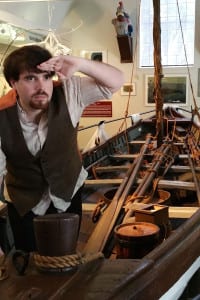Live performance recounts whale ship tragedy
By Ed Blair

On August 12, 1819, the Essex, a small but sturdy whaling ship piloted by 29-year-old Captain George Pollard, slipped her moorings and, with a following wind, sailed purposefully from the busy harbor of Nantucket, Massachusetts. Bound for Cape Horn and then on to the warm waters of the Pacific, Essex had a record of several financially successful voyages, and her crew of 20 hoped that their expected two-and-a-half-year expedition would be a profitable one. The whaling was indeed good, and, by November of 1820, Essex, now deep in the expansive South Pacific, was well on its way to completing yet another rewarding voyage. And then the unthinkable happened.
While Captain Pollard and his harpooners were on the hunt in their whaleboats, 23-year-old First Mate Owen Chase, aboard the ship, spotted in the distance a huge sperm whale — 85 feet by his reckoning — facing head-on toward the vessel. After spouting a few times, the leviathan inexplicably charged straight for Essex, smashing into her with what Chase later described as “an appalling and tremendous jar.” Not satisfied, the menacing giant, “as if distracted with rage and fury,” struck again, with devastating results. Essex went down, leaving her horror-struck crew to fend for themselves more than a thousand miles from the nearest land.
If the story strikes a familiar note, it is because the tales told by the Essex survivors were incorporated by author Herman Melville in penning his 1851 classic, “Moby-Dick.” Where Melville’s novel ended, however, the harrowing tale of Essex’s forsaken crew had only begun.
It is their incredible story, chronicled by Nathaniel Philbrick in his best seller “In the Heart of the Sea” (and also by Ron Howard in his newly released film by the same title), that The Whaling Museum & Education Center in Cold Spring Harbor is currently offering to share with visitors to the museum on Main Street in Cold Spring Harbor.
On Sunday, Dec. 27, and again on Saturday, Jan. 9, the museum will present college student actors who will perform, in full whaler garb, select scenes from the Philbrick book. Staged “in the round” inside an authentic whaleboat, the performance will offer a unique opportunity to gain insight into Long Island’s rich whaling history. The 30-foot whaleboat, built in an 1800s shipyard in Setauket, is fully equipped with its original gear according to Nomi Dayan, the museum’s executive director.
“While the Ron Howard movie may focus more on the whale’s attack, we differ in that we concentrate on how men pushed to their absolute limits were able to prevail,” she explained. Characterizing the local actors’ performance as “extremely professional,” Dayan added, “Our hope is that the interest aroused by the film stimulates an interest in an important part of Long Island’s past.”
The three-month odyssey of the crew members following the wreck of the Essex was one of torment and privation. At the mercy of the elements, they endured storms and starvation, and their desperation to survive eventually drove them to cannibalism. Eight men lived to tell the tale, Captain Pollard and First Mate Chase among them, and it was their rendering of the story that inspired Melville’s “Moby-Dick.”
The Whaling Museum & Education Center of Cold Spring Harbor is located at 279 Main Street. Both performances of the selected readings will start at 7 p.m. and will be followed by a question-and-answer session and include a wine and cheese reception as well as exhibit viewing. Seating is limited to 40 guests for each performance. Tickets, which are $20 per person and $35 per couple, can be reserved online at www.cshwhalingmuseum.org or by calling 631-367-3418.






